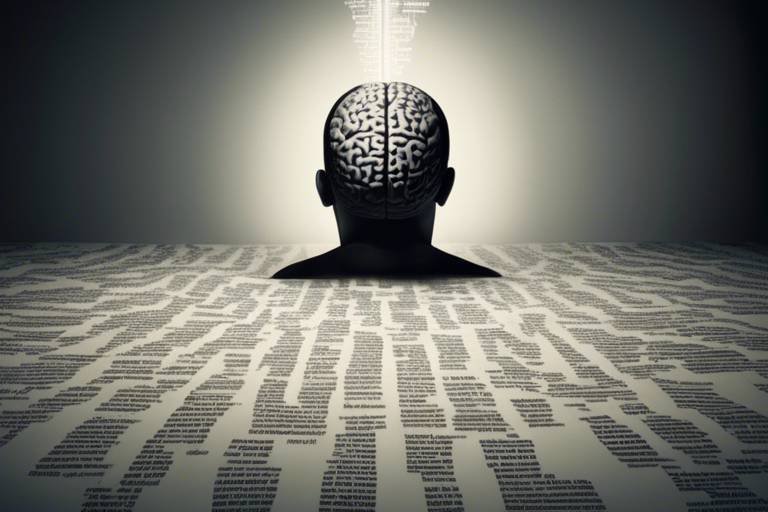The Mystery of Human Mind - Unraveling the Unknowns
The human mind is a vast, intricate landscape filled with mysteries that have puzzled thinkers for centuries. From the moment we wake up to the time we drift off to sleep, our minds are in constant motion, processing thoughts, emotions, and experiences. Have you ever wondered what really goes on in your head? Why do we feel joy, sadness, or anger? What makes us tick? These questions dive deep into the essence of our being, and while science has made significant strides in understanding this enigmatic organ, there are still countless unknowns waiting to be explored.
As we embark on this journey to unravel the complexities of the human mind, we will delve into various aspects such as consciousness, emotions, cognitive processes, and the profound impact of neuroscience. Each of these components plays a crucial role in shaping our experiences and understanding ourselves. Just like a masterful painting, the mind is layered with colors and textures, each representing different facets of our thoughts and feelings. In this article, we aim to peel back those layers, revealing the beauty and intricacy of our mental functions.
Imagine your mind as a bustling city, where thoughts are cars zooming through the streets, emotions are the traffic lights guiding them, and consciousness is the overarching skyline that gives structure to the chaos below. Each element interacts with the others, creating a dynamic system that defines who we are. By examining these components, we can gain insights into not only our personal experiences but also the universal themes that connect us all as human beings.
As we journey through the various sections of this article, we will explore the nature of consciousness, the powerful influence of emotions, the intricacies of cognitive processes, and how neuroscience sheds light on these mysteries. So, buckle up and get ready to navigate the fascinating world of the human mind, where every twist and turn reveals new insights and surprises.
Understanding consciousness is crucial to unraveling the human mind's mysteries. This section examines different theories and perspectives on what consciousness is and how it shapes our experiences.
Emotions play a significant role in our daily lives. This section explores how emotions are formed, their psychological impacts, and their influence on decision-making and behavior.
This subsection delves into the biological and psychological mechanisms behind emotions, exploring how they are processed in the brain and their evolutionary significance.
Different cultures perceive and express emotions uniquely. This part discusses how cultural contexts shape emotional experiences and expressions.
Emotional intelligence is vital for personal and professional success. This section explores its components and how it can be developed and enhanced.
The relationship between emotions and mental health is profound. This subsection examines how emotional regulation impacts mental well-being and the development of psychological disorders.
Cognitive processes are fundamental to understanding how we think, learn, and remember. This section provides insights into various cognitive functions and their implications for everyday life.
Memory is essential for learning and personal development. This subsection discusses the types of memory, how they work, and strategies to improve memory retention.
Decision-making is a complex cognitive process. This part examines the factors influencing our choices and the psychological biases that can affect our judgments.
- What is consciousness?
Consciousness is the state of being aware of and able to think about one's own existence, thoughts, and surroundings. It plays a crucial role in how we experience life.
- How do emotions affect decision-making?
Emotions significantly influence our decisions, often guiding our choices based on feelings rather than logic. Understanding this can help us make more balanced decisions.
- Can emotional intelligence be improved?
Yes! Emotional intelligence can be developed through practice and self-awareness. Techniques such as mindfulness and empathy training can enhance this skill.
- What is the connection between emotions and mental health?
Emotional regulation is vital for mental health. Poor emotional management can lead to various psychological disorders, highlighting the importance of understanding our feelings.

The Nature of Consciousness
Understanding consciousness is crucial to unraveling the mysteries of the human mind. It's like trying to decode a complex puzzle, where each piece represents a different facet of our existence. But what exactly is consciousness? Is it merely the awareness of our surroundings, or is it something deeper, more profound? Various theories have emerged over the years, each offering unique insights into this enigmatic phenomenon.
One popular perspective is the **philosophical** approach, which suggests that consciousness is a fundamental aspect of being. Think of it as the stage on which our thoughts and experiences play out. Philosophers like Descartes famously proclaimed, "I think, therefore I am," emphasizing that the very act of thinking is a testament to our existence. This raises intriguing questions: Are we truly aware, or are we simply reacting to stimuli without genuine understanding?
On the other hand, the **scientific** perspective delves into the biological underpinnings of consciousness. Neuroscience has made significant strides in identifying how different brain regions contribute to our conscious experience. For example, the prefrontal cortex is often associated with higher cognitive functions such as decision-making and self-awareness. In contrast, the thalamus acts as a relay station, channeling sensory information to the appropriate areas of the brain. This intricate network of interactions forms the basis of our conscious experience, but it leads to more questions than answers.
Moreover, consciousness isn't a binary state; it exists on a spectrum. At one end, we have full awareness, while at the other, we find altered states such as sleep or meditation. During these altered states, individuals may experience vivid dreams or profound insights, suggesting that consciousness can be fluid and dynamic. This idea opens up a fascinating realm of possibilities. Could it be that our understanding of consciousness is limited by our current experiences and perceptions?
To illustrate the complexity of consciousness, let's look at a few key theories:
| Theory | Description |
|---|---|
| Global Workspace Theory | Proposes that consciousness arises from the brain's ability to integrate information from various sources into a 'global workspace'. |
| Integrated Information Theory | Suggests that consciousness corresponds to the level of information integration within a system. |
| Higher-order Thought Theory | Posits that consciousness is a result of having thoughts about our thoughts. |
These theories, while distinct, share a common goal: to explain how consciousness emerges from the intricate workings of the brain. As we delve deeper into the nature of consciousness, we uncover the profound implications it holds for our understanding of identity, free will, and the essence of what it means to be human.
Ultimately, the quest to understand consciousness is not just an academic exercise; it touches upon the very core of our existence. As we continue to explore this fascinating topic, we may find that the answers lie not only in the brain's biology but also in the rich tapestry of human experience. So, what do you think? Is consciousness merely a byproduct of neural activity, or is there something more at play?
Stay tuned as we continue to unravel the complexities of the human mind, and remember, the journey of discovery is as important as the destination.
- What is consciousness? Consciousness refers to the state of being aware of and able to think about one's own existence, thoughts, and surroundings.
- How does neuroscience study consciousness? Neuroscience studies consciousness by examining brain activity and identifying which areas are activated during different conscious experiences.
- Are there different types of consciousness? Yes, consciousness exists on a spectrum, ranging from full awareness to altered states such as sleep or meditation.

Emotions and Their Influence
Emotions are the vibrant colors that paint our daily lives, influencing our thoughts, actions, and interactions with others. They are not just fleeting feelings; they are powerful forces that shape our experiences and decisions. Have you ever noticed how a simple smile can brighten your day or how a moment of anger can lead to regrettable choices? This is the essence of emotions—they are deeply intertwined with our existence, acting as both guides and disruptors. Understanding how emotions work can empower us to harness their potential while mitigating their negative impacts.
At the core of our emotional experience lies a fascinating interplay between our biological makeup and psychological processes. Emotions are formed through a complex combination of our thoughts, physical reactions, and environmental stimuli. For instance, when faced with a stressful situation, your body might react with increased heart rate and sweating, signaling feelings of anxiety or fear. This physiological response is not just an involuntary reaction; it’s a signal that prompts us to evaluate our circumstances and make decisions. Thus, emotions can serve as a barometer for our well-being, guiding us toward choices that align with our needs and values.
One of the most intriguing aspects of emotions is their profound impact on decision-making. Studies have shown that our emotional state can significantly influence the choices we make, often overriding logical reasoning. For example, when we are feeling joyful, we might be more inclined to take risks or embrace new opportunities, while feelings of sadness or fear can lead to avoidance behaviors. This emotional influence is not merely anecdotal; it’s supported by research in psychology that highlights the role of emotions in cognitive processing. Emotions can act as shortcuts, helping us to quickly assess situations and make decisions, but they can also lead to biases that cloud our judgment.
Moreover, emotions are not experienced in a vacuum; they are shaped by our cultural contexts and social environments. Different cultures have unique ways of expressing and interpreting emotions, which can affect interpersonal relationships and communication. For instance, in some cultures, expressing emotions openly is encouraged, while in others, it may be viewed as a sign of weakness. This cultural lens can lead to misunderstandings and conflicts, but it also enriches our emotional experiences, offering diverse perspectives on what it means to feel and express emotions.
In addition to cultural influences, the concept of emotional intelligence (EI) emerges as a crucial component in navigating our emotional landscapes. Emotional intelligence encompasses the ability to recognize, understand, and manage our own emotions, as well as the emotions of others. Developing EI can lead to enhanced personal and professional relationships, improved communication, and greater resilience in the face of challenges. It’s like having a compass that guides us through the stormy seas of our emotional world, helping us to stay grounded and make informed choices.
However, it’s important to acknowledge that emotions can also have a darker side. Poor emotional regulation can contribute to mental health issues such as anxiety, depression, and other psychological disorders. Understanding the relationship between emotions and mental health is vital for fostering well-being. By learning to manage our emotions effectively, we can improve our mental health and overall quality of life. This might involve practices such as mindfulness, therapy, or simply taking a moment to breathe and reflect before reacting to a situation.
In conclusion, emotions are not just ephemeral feelings; they are powerful agents that influence our lives in profound ways. By exploring the science behind emotions and understanding their impact on our decision-making, cultural expressions, and mental health, we can better navigate the complexities of our emotional experiences. So, the next time you find yourself feeling a surge of emotion, take a step back and recognize the incredible power it holds—not just over you, but over your entire world.
- What are emotions? Emotions are complex psychological states that involve physiological arousal, expressive behaviors, and conscious experience.
- How do emotions affect decision-making? Emotions can significantly influence our choices, often leading us to make decisions based on feelings rather than rational thought.
- What is emotional intelligence? Emotional intelligence is the ability to recognize, understand, and manage our own emotions and the emotions of others.
- Can emotions impact mental health? Yes, poor emotional regulation can lead to mental health issues such as anxiety and depression.

The Science of Emotions
Emotions are often described as the *colorful threads* woven into the fabric of our daily lives. They are not just fleeting feelings; they are complex responses that involve our thoughts, physiological reactions, and behaviors. Understanding the science of emotions is crucial for grasping how they influence our actions and interactions. At the core of emotional science lies the brain, which processes these feelings in a way that can sometimes feel like a *mysterious alchemy*.
To break it down, emotions arise from a combination of biological and psychological mechanisms. When we experience an emotion, our brain's limbic system—which includes structures like the amygdala and hippocampus—plays a pivotal role. The amygdala, often dubbed the *emotion center*, is particularly responsive to threats and rewards, acting as an alarm system that triggers our fight-or-flight response. Meanwhile, the hippocampus helps us contextualize these emotions by linking them to past experiences, which is why a familiar scent can evoke a flood of memories.
From a biological standpoint, emotions can be categorized into basic emotions, such as happiness, sadness, anger, fear, surprise, and disgust. These emotions are universal, transcending cultural boundaries, and are often accompanied by distinct physiological changes. For instance, when we feel fear, our heart rate increases, palms may sweat, and we might feel a rush of adrenaline. This is our body preparing to either confront or flee from danger—a response hardwired into our biology.
Moreover, the evolutionary significance of emotions cannot be overlooked. Emotions have developed over millennia to enhance our survival. For example, fear can protect us from harm, while joy can strengthen social bonds. In this sense, emotions serve as a *social glue*, helping us navigate complex social landscapes. They allow us to communicate our feelings to others, fostering empathy and connection.
But how do we actually experience these emotions? The answer lies in the interplay between our thoughts and feelings. Cognitive appraisal theory suggests that our interpretation of a situation significantly influences our emotional response. For instance, if you receive unexpected criticism at work, your interpretation of that feedback—whether you see it as a personal attack or a chance for growth—will shape your emotional reaction. This highlights the importance of perspective in emotional experiences.
In addition to the biological and cognitive aspects, cultural factors also play a significant role in how we express and understand emotions. Different cultures have unique emotional norms, which can affect everything from how we display happiness to how we cope with grief. For example, in some cultures, expressing emotions openly is encouraged, while in others, restraint is valued. This cultural lens adds another layer of complexity to the science of emotions, emphasizing that while we may all feel similar emotions, the way we express them can vary widely.
As we delve deeper into the science of emotions, we uncover fascinating insights that can help us improve our emotional intelligence—a skill that is increasingly recognized as vital for personal and professional success. By understanding the mechanisms behind our emotions, we can learn to navigate them more effectively, leading to better relationships and improved mental health.
In summary, the science of emotions is a rich and intricate field that combines biology, psychology, and cultural studies. It reveals that emotions are not just random feelings but are deeply rooted in our biology and shaped by our experiences and environments. As we continue to explore this fascinating realm, we can gain a better understanding of ourselves and the intricate dance of emotions that defines the human experience.
- What are the basic emotions? The basic emotions include happiness, sadness, anger, fear, surprise, and disgust.
- How do emotions affect decision-making? Emotions can significantly influence our choices, often leading us to make decisions based on feelings rather than logic.
- Can emotional intelligence be developed? Yes, emotional intelligence can be enhanced through practice and self-awareness.
- What role does culture play in emotions? Culture shapes how we express and interpret emotions, influencing our emotional experiences.

Cultural Perspectives on Emotions
When we talk about emotions, it's fascinating to realize how they are not just personal experiences but are also deeply intertwined with cultural contexts. Different cultures have unique ways of interpreting, expressing, and managing emotions, which can significantly influence our interactions and relationships. For instance, in some cultures, expressing emotions openly is encouraged, while in others, it may be viewed as a sign of weakness or a lack of self-control. This cultural lens shapes not only how we feel but also how we perceive the feelings of others.
Take, for example, the concept of collectivism versus individualism. In collectivist cultures, such as those found in many Asian countries, emotions are often expressed in a way that maintains harmony and group cohesion. Here, the emotional experience is shared, and individuals may downplay their feelings for the sake of the group. Conversely, in individualistic cultures, like those in the United States and much of Western Europe, people are encouraged to express their emotions freely and assert their personal feelings. This difference can lead to misunderstandings in cross-cultural interactions, where one party may perceive the other as either too reserved or overly dramatic.
Moreover, cultural norms dictate not just how emotions are expressed but also which emotions are considered appropriate. For instance, in some cultures, showing sadness might be seen as a natural response to loss, while in others, it could be frowned upon, leading individuals to suppress their grief. This suppression can have profound effects on mental health, as individuals may struggle to reconcile their internal feelings with external expectations.
Interestingly, the way emotions are interpreted can also vary widely. For example, the emotion of anger might be viewed as a negative reaction in some cultures, leading to avoidance of confrontational situations. In contrast, other cultures may see anger as a legitimate and even necessary response to injustice, promoting a more direct approach to conflict resolution. This divergence highlights the importance of understanding cultural frameworks when navigating emotional experiences.
In addition to expressing emotions, cultural perspectives also influence how we manage and regulate our emotions. For instance, practices such as mindfulness and meditation, which are rooted in certain Eastern philosophies, encourage individuals to observe their emotions without judgment, fostering a sense of emotional awareness and regulation. On the other hand, Western approaches might focus more on cognitive restructuring, where individuals are taught to change their thought patterns to alter their emotional responses.
To further illustrate these cultural differences, consider the following table that summarizes various cultural perspectives on key emotions:
| Emotion | Individualistic Cultures | Collectivist Cultures |
|---|---|---|
| Happiness | Celebrated openly and often. | Shared among the group; individual happiness is secondary. |
| Sadness | Expressed freely; seen as a personal experience. | May be suppressed to maintain group harmony. |
| Anger | Asserted as a valid emotion; encouraged to confront. | Often avoided; seen as disruptive to group dynamics. |
| Fear | Discussed openly; seen as a personal challenge. | May be shared but often downplayed to avoid worry. |
In conclusion, understanding the cultural perspectives on emotions is essential for fostering empathy and improving communication in our increasingly globalized world. By recognizing that our emotional responses are shaped by cultural influences, we can better navigate the complexities of human interactions and build stronger, more meaningful connections with those around us.
- How do cultural differences impact emotional expression? Cultural differences can dictate how emotions are expressed, perceived, and regulated. Some cultures encourage open expression, while others promote restraint.
- What role does culture play in emotional intelligence? Culture influences the development of emotional intelligence by shaping how individuals recognize, interpret, and respond to their own emotions and those of others.
- Can understanding cultural perspectives improve mental health? Yes, understanding cultural perspectives can enhance emotional regulation and communication, leading to better mental health outcomes.

Emotional Intelligence
Emotional intelligence, often abbreviated as EI or EQ (emotional quotient), is more than just a buzzword; it's a crucial skill that can significantly impact both our personal and professional lives. But what exactly does it mean? At its core, emotional intelligence refers to the ability to recognize, understand, and manage our own emotions while also being aware of and influencing the emotions of others. Think of it as having a sort of emotional GPS that guides us through the complexities of human interactions.
Why is emotional intelligence so important? Well, consider this: in a world where technical skills are often prioritized, it's the ability to connect with others that often makes the difference between success and struggle. Research shows that individuals with high emotional intelligence tend to excel in leadership roles, build stronger relationships, and navigate social complexities with ease. They are often seen as more empathetic and approachable, which can lead to better collaboration and teamwork.
So, how can we develop and enhance our emotional intelligence? Here are some key components to focus on:
- Self-awareness: This is the foundation of emotional intelligence. It involves recognizing your own emotions and understanding how they affect your thoughts and behavior. Keeping a journal or practicing mindfulness can help improve self-awareness.
- Self-regulation: Once you're aware of your emotions, the next step is managing them. This means controlling impulsive feelings and behaviors, maintaining a sense of calm in stressful situations, and being adaptable to change.
- Motivation: High emotional intelligence often correlates with intrinsic motivation. This means being driven by internal rewards rather than external ones. Setting personal goals and striving for self-improvement can enhance your motivation levels.
- Empathy: Understanding and sharing the feelings of others is crucial. Empathy allows us to build deeper connections and respond appropriately to the emotional states of those around us.
- Social skills: Finally, strong social skills are essential for managing relationships. This includes effective communication, conflict resolution, and the ability to inspire and influence others.
Incorporating these components into your daily life can lead to significant improvements in how you interact with others and how you handle your own emotions. For instance, practice active listening during conversations, which not only demonstrates empathy but also builds trust and rapport. Furthermore, when faced with challenging emotional situations, take a moment to breathe and reflect before reacting. This simple pause can prevent misunderstandings and foster more productive discussions.
Ultimately, emotional intelligence is not a fixed trait; it's a skill that can be nurtured and developed over time. Just like physical fitness, enhancing your emotional intelligence requires consistent effort and practice. So, why not start today? Engaging in self-reflection, seeking feedback from trusted friends, or even enrolling in workshops can set you on the path to becoming more emotionally intelligent.
1. Can emotional intelligence be learned?
Yes, emotional intelligence can be developed through practice and self-reflection. Many resources, including books, courses, and workshops, are available to help individuals enhance their emotional intelligence.
2. How does emotional intelligence affect leadership?
Leaders with high emotional intelligence can better understand and motivate their teams, handle conflicts more effectively, and create a positive work environment, leading to improved overall performance.
3. Is emotional intelligence more important than IQ?
While IQ measures cognitive abilities, emotional intelligence is often considered equally, if not more, important for success in personal and professional relationships. Emotional intelligence enables individuals to navigate social complexities and build meaningful connections.
4. What are some signs of high emotional intelligence?
Signs of high emotional intelligence include strong communication skills, empathy, self-awareness, the ability to manage stress, and the capacity to resolve conflicts amicably.

Emotions and Mental Health
When we talk about emotions, we often think of them as fleeting feelings that come and go, but the truth is, they play a monumental role in our mental health. Imagine emotions as the colors in a painting; they can either brighten our day or darken our mood, shaping our experiences and perceptions. The relationship between emotions and mental health is a complex tapestry woven from various threads of psychology, biology, and personal experience. Understanding this connection can be the key to unlocking better mental well-being.
At the core of this relationship lies the concept of emotional regulation. This refers to our ability to manage and respond to our emotional experiences. When we effectively regulate our emotions, we often find ourselves navigating life’s challenges with greater ease. However, when our emotional regulation falters, it can lead to a cascade of mental health issues, such as anxiety, depression, and other psychological disorders. For instance, individuals who struggle to express their emotions may bottle them up, leading to feelings of isolation and despair.
Research indicates that poor emotional regulation is closely linked to various mental health conditions. Here’s a quick overview of how emotions and mental health intersect:
| Mental Health Condition | Emotional Regulation Challenges |
|---|---|
| Anxiety Disorders | Difficulty managing fear and worry |
| Depression | Struggles with sadness and hopelessness |
| Bipolar Disorder | Extreme emotional fluctuations |
| Borderline Personality Disorder | Intense and unstable emotions |
Moreover, the impact of emotions on mental health is not just a one-way street. Our mental state can also influence how we experience and express emotions. For example, someone who is feeling depressed may perceive neutral situations as negative, skewing their emotional responses. This creates a vicious cycle where negative emotions exacerbate mental health issues, making it increasingly challenging to break free.
Interestingly, emotional intelligence plays a pivotal role in this dynamic. Individuals with high emotional intelligence tend to have better mental health outcomes because they can recognize, understand, and manage their emotions effectively. This skill not only enhances personal relationships but also improves coping mechanisms during stressful times. Developing emotional intelligence involves:
- Self-awareness: Recognizing your own emotions and their impact.
- Self-regulation: Managing emotions in a healthy way.
- Empathy: Understanding the emotions of others.
- Social skills: Building and maintaining healthy relationships.
In conclusion, the interplay between emotions and mental health is profound and multifaceted. By enhancing our emotional regulation and emotional intelligence, we can pave the way for improved mental well-being. It’s like tuning a musical instrument; when each string is in harmony, the resulting melody is beautiful and fulfilling. So, let’s embrace our emotions, learn to manage them, and ultimately, nurture our mental health.
- What is emotional regulation? Emotional regulation is the ability to manage and respond to emotional experiences effectively.
- How do emotions affect mental health? Poor emotional regulation can lead to mental health issues like anxiety and depression.
- What is emotional intelligence? Emotional intelligence is the ability to recognize, understand, and manage emotions in oneself and others.
- Can improving emotional intelligence help with mental health? Yes, it can lead to better emotional regulation and improved mental health outcomes.

Cognitive Processes Explained
Understanding cognitive processes is like peering into the intricate machinery of our minds. It's fascinating how these processes govern our ability to think, learn, and remember. Cognitive functions are not just abstract concepts; they are the very foundation of our daily interactions and decision-making. Whether you’re solving a math problem, recalling a cherished memory, or deciding what to have for dinner, cognitive processes are at play. They encompass a range of mental activities that include perception, attention, memory, reasoning, and language, all working harmoniously to shape our understanding of the world.
At the heart of cognitive processes lies memory, which is crucial for learning and personal development. Memory is not a singular entity; it can be categorized into different types, each serving a unique purpose. For instance, short-term memory allows us to hold information temporarily, while long-term memory enables us to store information for extended periods, sometimes even for a lifetime. Understanding how these types of memory operate can provide insights into improving our learning techniques and retaining information more effectively.
To illustrate the types of memory, consider the following table:
| Type of Memory | Description | Duration |
|---|---|---|
| Short-term Memory | Holds a small amount of information for a brief period. | Seconds to a minute |
| Long-term Memory | Stores information over an extended period, potentially indefinitely. | Days to a lifetime |
| Working Memory | Active processing and manipulation of information for cognitive tasks. | Seconds to minutes |
Another essential cognitive function is decision-making. This process involves evaluating options and making choices based on various factors, including personal experiences, emotions, and cognitive biases. Have you ever wondered why we sometimes make irrational decisions? It’s often because our brains are wired to rely on shortcuts, known as heuristics, which can lead to biased judgments. For example, the availability heuristic causes us to overestimate the likelihood of events based on how easily we can recall similar instances. Recognizing these biases can empower us to make more informed decisions.
Moreover, cognitive processes are influenced by our environment and experiences. For instance, the way we perceive and interpret information can vary dramatically from one person to another, shaped by cultural backgrounds, educational experiences, and even emotional states. This brings us to the importance of metacognition, or thinking about our thinking. By developing metacognitive strategies, we can enhance our learning and problem-solving abilities, allowing us to assess our thought processes and make adjustments as needed.
In conclusion, cognitive processes are fundamental to our existence. They not only dictate how we interact with the world but also shape our identities and experiences. By understanding these processes better, we can unlock our potential for learning and growth, ultimately leading to a richer, more fulfilling life. So, the next time you find yourself pondering a decision or trying to recall a memory, remember that a complex web of cognitive functions is working tirelessly behind the scenes to guide you.
- What are cognitive processes? Cognitive processes refer to the mental activities involved in acquiring knowledge and understanding, including thinking, learning, memory, and decision-making.
- How can I improve my memory? Techniques such as mnemonic devices, spaced repetition, and engaging in regular mental exercises can help enhance memory retention.
- What role do emotions play in decision-making? Emotions can significantly influence our choices, often leading us to make decisions based on feelings rather than logic.
- Can cognitive biases be overcome? While cognitive biases are a natural part of human thinking, being aware of them can help mitigate their effects on our decision-making.

Memory and Learning
Memory is like the glue that holds our experiences together, allowing us to learn and grow throughout our lives. It’s fascinating to think about how our brains store information, almost like a vast library filled with books, each representing a moment, a lesson, or a skill we’ve acquired. But how does this complex system work? Let’s dive into the different types of memory and the processes that underpin our ability to learn.
At its core, memory can be divided into three main types: sensory memory, short-term memory, and long-term memory. Sensory memory allows us to retain impressions of sensory information for a very brief period, typically less than a second. For example, when you see a flash of lightning, your sensory memory captures that image just long enough for your brain to process it. Short-term memory, on the other hand, holds information for a slightly longer duration, usually around 20 to 30 seconds. This is where you might remember a phone number just long enough to dial it. Finally, long-term memory is where we store information for extended periods, potentially for a lifetime. This is where all those precious memories and learned skills reside.
Now, how do we enhance our memory retention? Here are some effective strategies:
- Repetition: The more we practice or review information, the stronger the neural connections become.
- Mnemonics: These memory aids can help you remember complex information through patterns or associations.
- Visualization: Creating mental images can help solidify information in your mind.
- Chunking: Breaking down large amounts of information into smaller, manageable units makes it easier to remember.
Learning is not just about memorizing facts; it's about understanding and applying knowledge in real-world situations. This is where the concept of active learning comes into play. Active learning involves engaging with the material through discussions, problem-solving, and hands-on activities. It’s like diving into a swimming pool instead of just reading about how to swim. The more actively involved you are in your learning process, the better you’ll retain the information.
Moreover, our emotional state can significantly impact our ability to learn and remember. Have you ever noticed how you can easily recall a moment of joy or sadness? That’s because emotions can enhance memory retention. The brain releases neurotransmitters during emotional experiences that strengthen the memories associated with those feelings. This connection is why storytelling can be such a powerful educational tool—when we connect with the story emotionally, we're more likely to remember it.
In conclusion, memory and learning are intricately linked, with each type of memory serving a unique purpose in our cognitive processes. By understanding how memory works and employing effective learning strategies, we can enhance our ability to learn and retain information throughout our lives. So, the next time you’re trying to memorize something, remember: it’s not just about rote memorization; it’s about making connections, engaging with the material, and allowing your emotions to play a role in the learning process.
Q: What are the different types of memory?
A: The three main types of memory are sensory memory, short-term memory, and long-term memory. Each serves a different function in the process of learning and retention.
Q: How can I improve my memory?
A: You can improve your memory through repetition, mnemonics, visualization, and chunking information into smaller parts.
Q: What is active learning?
A: Active learning involves engaging with the material through discussions, problem-solving, and practical activities, which enhances understanding and retention.
Q: How do emotions affect memory?
A: Emotions can enhance memory retention by strengthening the neural connections associated with emotional experiences, making it easier to recall those memories later.

Decision-Making Processes
Decision-making is an intricate dance of cognitive processes that shapes our everyday lives. Imagine standing at a crossroads, each path representing a different choice, and the weight of each decision pressing down on your shoulders. How do we navigate such complexities? At its core, decision-making involves a series of steps that include identifying the problem, gathering information, evaluating alternatives, and ultimately making a choice. This process isn’t just a mechanical function; it’s a blend of logic, emotion, and even intuition.
Interestingly, our decisions are influenced by a myriad of factors, both internal and external. For instance, personal experiences and cultural backgrounds can significantly alter how we perceive options. When faced with a decision, our brain employs various cognitive biases—systematic patterns of deviation from norm or rationality in judgment—that can skew our choices. Some common biases include:
- Confirmation Bias: The tendency to search for, interpret, and remember information in a way that confirms one’s preconceptions.
- Anchoring Bias: Relying too heavily on the first piece of information encountered (the "anchor") when making decisions.
- Overconfidence Bias: Holding a belief that we are better than we actually are at predicting outcomes.
These biases can lead us to make suboptimal decisions, often without us even realizing it. For example, in a business setting, a manager might stick to a failing strategy simply because it was their initial choice, ignoring new evidence that suggests a change is necessary. This is where the importance of awareness comes into play. By recognizing these biases, we can take steps to mitigate their effects, leading to more informed and rational decisions.
Moreover, the environment in which decisions are made can also have a profound impact. Stress, time pressure, and social influences can cloud judgment, pushing individuals toward impulsive choices rather than thoughtful deliberation. For instance, research shows that making decisions under stress often leads to a reliance on heuristics—mental shortcuts that simplify decision-making but can also result in errors.
To enhance decision-making skills, one can adopt several strategies:
- Pause and Reflect: Taking a moment to breathe and consider the options can help clear the mind.
- Seek Diverse Perspectives: Engaging with others can provide new insights and challenge existing biases.
- Evaluate Outcomes: After a decision is made, reflecting on the outcomes can improve future decision-making.
In conclusion, the decision-making process is a fascinating interplay of cognitive functions, emotions, and external factors. By understanding the mechanics behind our choices, we can become more adept at navigating the complexities of life. Whether it’s a simple choice like what to have for dinner or a significant decision that could alter the course of our lives, being aware of how we make decisions empowers us to choose wisely.
Q1: What are the key steps in the decision-making process?
A1: The key steps include identifying the problem, gathering information, evaluating alternatives, making a choice, and reflecting on the decision.
Q2: How do cognitive biases affect decision-making?
A2: Cognitive biases can lead to irrational decisions by skewing our perception and judgment, often causing us to overlook important information.
Q3: Can decision-making skills be improved?
A3: Yes, decision-making skills can be enhanced through practice, awareness of biases, and by seeking input from diverse perspectives.
Q4: What role does emotion play in decision-making?
A4: Emotions can significantly influence our choices, sometimes leading to impulsive decisions or, conversely, helping us make empathetic and thoughtful choices.
Frequently Asked Questions
- What is consciousness and why is it important?
Consciousness refers to our awareness of ourselves and our environment. It’s the lens through which we perceive reality, making it crucial for personal experiences, decision-making, and social interactions. Understanding consciousness helps us grasp how we think, feel, and relate to the world around us.
- How do emotions impact our daily lives?
Emotions are like the soundtrack to our lives, influencing our decisions, behaviors, and interactions. They can motivate us to take action, help us connect with others, and even guide our moral compass. When we understand our emotions, we can navigate life’s challenges more effectively.
- What is emotional intelligence and why is it essential?
Emotional intelligence (EI) is the ability to recognize, understand, and manage our own emotions while also empathizing with others. It’s essential because it enhances our relationships, improves communication, and fosters better teamwork, making it a key ingredient for success both personally and professionally.
- How do cultural perspectives shape our emotions?
Cultural contexts play a significant role in how we express and interpret emotions. For example, some cultures encourage open emotional expression, while others may promote restraint. Understanding these differences can help us communicate better and appreciate diverse emotional experiences.
- What are the types of memory, and how do they work?
Memory can be categorized into several types, including short-term, long-term, and working memory. Short-term memory holds information temporarily, while long-term memory stores experiences and knowledge. Working memory allows us to manipulate information actively. Knowing how these types function can help us develop strategies for better retention and recall.
- What factors influence our decision-making processes?
Decision-making is influenced by various factors, including emotions, cognitive biases, social pressures, and prior experiences. Understanding these influences can help us make more informed and rational choices, reducing the likelihood of regret or second-guessing.
- How can emotional regulation affect mental health?
Emotional regulation is crucial for maintaining mental health. It involves managing and responding to emotional experiences in a healthy way. Poor emotional regulation can lead to stress, anxiety, and depression, while effective regulation can promote resilience and well-being.



















